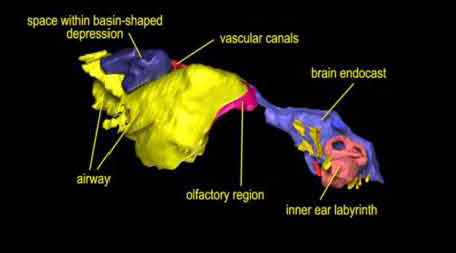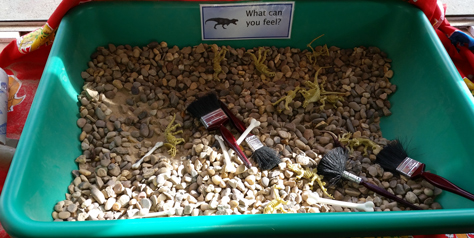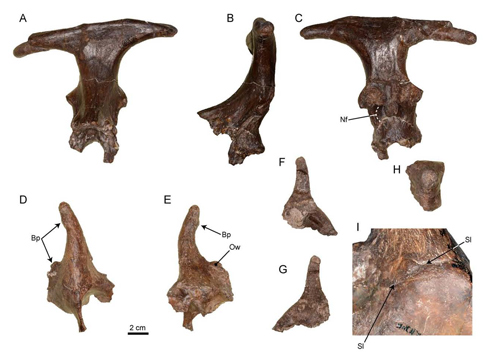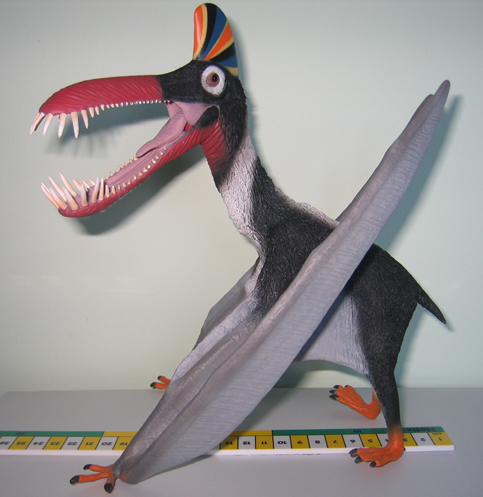Australia’s Newest Dinosaur Described in New Scientific Paper
Kunbarrasaurus ieversi – Sheep-sized Armoured Dinosaur from Australia
Australia has its newest dinosaur. Kunbarrasaurus has been identified from fossil remains formerly described as Minmi paravertebra following an in-depth, three-dimensional analysis of the skull. This sheep-sized armoured dinosaur roamed what was to become Queensland around 100 million years ago.
A New Armoured Dinosaur from Australia Kunbarrasaurus
The fossil material, including a very well preserved skull was discovered in 1989 and assigned to the genus Minmi, however, extensive analysis of the fossil began in 2007 and the specimen was subjected to extensive CT scanning and three-dimensional modelling to reconstruct the palate, braincase, inner ear and nasal cavities. The research team found that this basal member of the clade Ankylosauria was sufficient different from Minmi to warrant setting up in its own genus.
An Illustration of the Lightly Armoured Kunbarrasaurus (K. ieversi)
Picture credit: University of Queensland/Australian Geographic
The fossil which is partially articulated, was found eroding out of the mudstone rock exposed at Marathon Station, near Richmond (north-western Queensland). The strata which makes up the Allaru Formation from which the specimen was excavated, represents a shallow, low energy marine environment. It is likely that the corpse of this two-metre-long dinosaur was washed out to sea. Or perhaps this dinosaur was washed out to sea and drowned, either way, its carcase sank and settled on the seabed and it was quickly buried providing excellent conditions for fossilisation and fossil preservation.
The Fossilised Remains of Kunbarrasaurus
Picture credit: University of Queensland
Significant Ankylosaur Discovery
The fossils, part of the Queensland Museum collection, represent the most complete dinosaur fossil found to date from eastern Gondwana (Antarctica, India, New Zealand and Australia). In addition, it is the most complete ankylosaurian fossil known from that ancient, southern super-continent. The cranial material (skull) is exceptional. It is one of the few skulls associated with the Ankylosauria clade in which the sutures have not fused or been obliterated by the presence of heavy, dermal armour or the remodelling of bone.
The name Kunbarrasaurus (pronounced koon-bah-rah-sore-us) means “shield lizard” in the local Mayi language of the indigenous Wunumara people from this part of Queensland. The species name honours Mr Ian Ievers, the property manager at Marathon Station who discovered the fossil.
Commenting on the study, lead researcher Lucy Leahey, a PhD student at Queensland University stated:
“Ankylosaurs were a group of four-legged, herbivorous dinosaurs, closely related to stegosaurs. Like crocodiles, they had bones in their skin and are commonly referred to as ‘armoured’ dinosaurs.” When it was first studied back in the 1990s, the fossil was placed it in the same genus as Australia’s only other named Ankylosaur, Minmi, which is based on some bones from Roma in south-western Queensland.”
Computerised Tomography Yields Clues to Identity
Although a total of seven fossil specimens had been assigned to the genus Minmi, only two had been studied in detail. In collaboration with scientists from the Denver Museum of Nature and Science the specimen was subjected to a detailed CT scan and from this Professor Lawrence Witmer (Ohio University) was able to reconstruct a complex, three-dimensional model of the skull, the nasal cavities and the inner ear.
Three Dimensional Cranial Osteology Study of Kunbarrasaurus
Picture credit: University of Queensland
Kunbarrasaurus
Professor Witmer added:
“The CT reconstruction revealed that Kunbarrasaurus had a more complicated airway than other dinosaurs, but less so than ankylosaurs from the Northern Hemisphere. The inner ear is proportionately enormous and unlike anything we have seen before in a dinosaur.”
Explaining that the inner ear configuration resembles that seen in a Tuatura or a turtle the scientists remain puzzled as to this complicated structures purpose.
One of the paper’s authors Dr Steve Salisbury (Queensland University) stated that the team did not know why the inner ear was shaped in this way. In addition, the nasal (airway) passages in the skull were also very sophisticated, but not as those seen in more derived, later ankylosaurs found in North America. These airways could have helped to give this plant-eating dinosaur a powerful sense of smell, or they may have helped keep the brain cool.
For the moment, Kunbarrasaurus has been classified as basal member of the Ankylosauria clade, Dr Salisbury said:
“It [Kunbarrasaurus] appears to represent an early, less heavily armoured member of the group, close to the point at which the Ankylosaurs diverged from the other main lineage of armoured dinosaurs, the Stegosaurs.”
A Single Fossilised Footprint
A single fossilised footprint found in south-eastern Queensland indicates that there may have been at least one type of Stegosaur that lived in this part of the world during the Middle Jurassic. A spokesperson from Everything Dinosaur commented:
“There is some tantalising evidence to suggest that a number of different types of thyreophoran dinosaur existed in what was to become Queensland during the Jurassic and into the Early Cretaceous. Tracks and footprints have been recorded from a number of locations and from a number of different aged strata but body fossils are exceptionally rare. Kunbarrasaurus is only the second armoured dinosaur to be named from Australia.”
For replicas and models of armoured dinosaurs and prehistoric animals: PNSO Age of Dinosaurs Replicas.

























